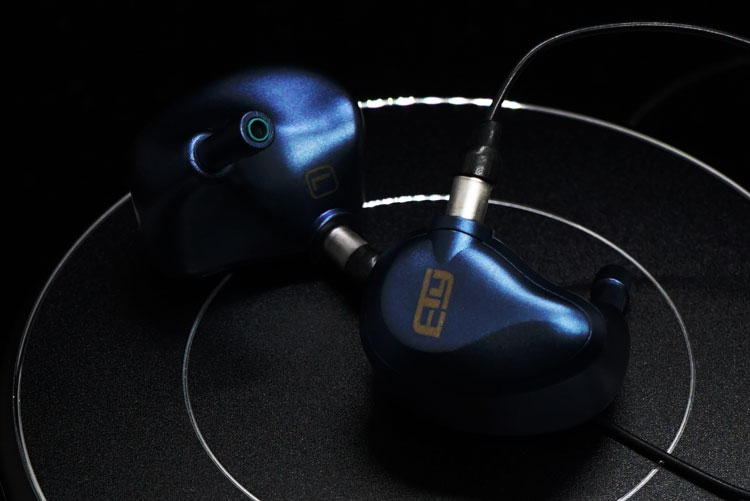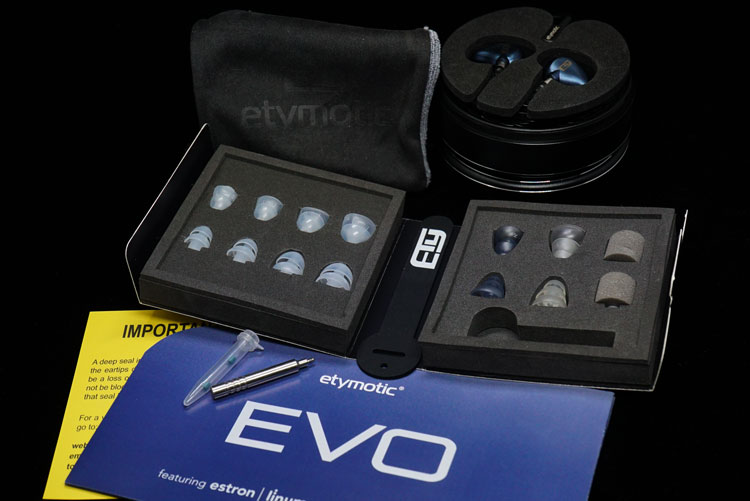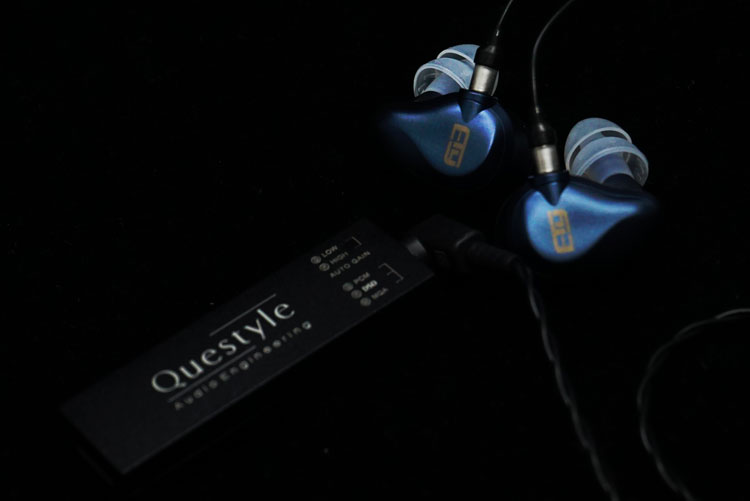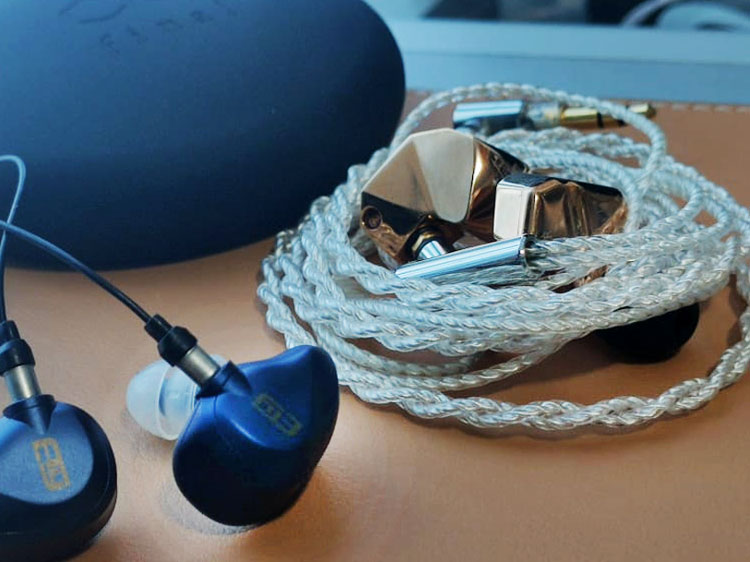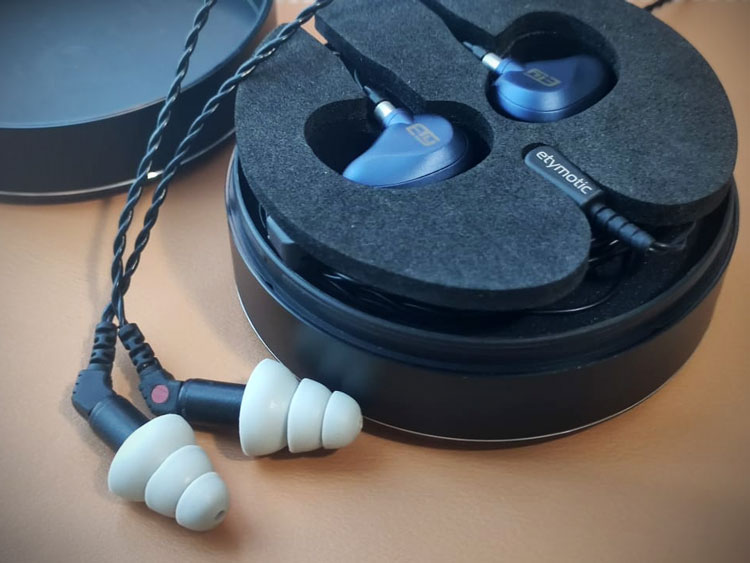Etymotic EVO is a multi-driver universal IEM featuring a custom joined triple BA driver module and Linum BaX T2 cabling. It is priced at £499.94.
Disclaimer: The Etymotic EVO was sent to us in exchange for our honest opinion. Thank you to Etymotic and Hifiheadphones.co.uk for giving us this opportunity.
You can read more about other Etymotic products reviewed on Headfonics here.
Note, this 2-page review follows our new scoring guidelines for 2020 which you can read up on here.
Against 30 years of persistence in single-driver designs, Etymotic’s latest move to build the triple BA IEM “EVO” is a bit of a surprise.
The design is changed in and out, intriguing enough it doesn’t use the company’s signature “rod” housing design as well as their insanely deep ear canal insertion technique.
Is this a revolution and does it sound “true to the ear” like the brand name denotes? And what design gives them the confidence to launch a non-single-driver item after 3 decades? We are here to find out!
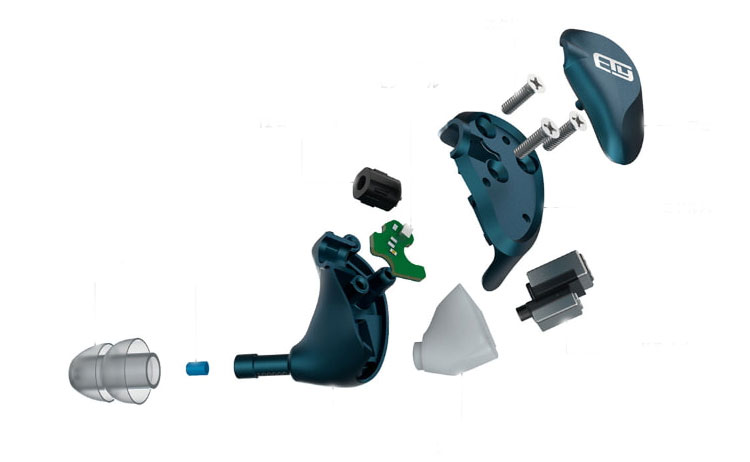
Tech Highlights
Etymotic claims that the EVO is the most accurate multi-driver earphone on the market, and possibly they are one of the most legit companies to say that with their proven designs.
Consisting of 3 BAs with a two-way crossover, the drivers are housed in a special acoustic module within a metal injection molded, stainless-steel housing to produce Etymotic’s house signature.
This is quite a premium feature considering its price, the whole package is much more appealing and seems to target audiophiles more than pro users this time.
As a part of the design an Estron Linum BaX T2™ system cable tags along, which is extremely lightweight and tough. The connectors are using a minimalist design that is efficient and extremely compact, making the user experience complete and more ergonomically designed than most of the competition.
Design
The EVO, unlike the anodized, laser-etched aluminum crafted ER series, has moved on to stainless-steel injection molding. The housing is heat-formed with metal powder and resin, pressurized into a few geometrically complex parts that fuse together as one. The result is a very artistic and streamlined shape and a beautiful finish.
The smooth flowing curve on the EVO looks gorgeous and the design is completely free of screws. On top of the faceplate, you will find an ETY logo that denotes the company’s name. You may as well notice the insertion depth is shorter than the rod-style ER series designs.
Comfort & Isolation
Isolation with Etymotic is usually very good. The EVO comes with a few sets of dual and triple flanges that will offer top-notch noise isolation, perhaps even more passive noise blocking power than some custom IEMs with its deep insertion and extreme sealing properties.
However, the insertion depth feels less deep than the ER series on the same triple flange and that seems to help the bass to sound bigger.
The body cradles cozily on the ear’s concha, and it is very comfortable to wear but may take some time for you to find the best match of flanges or foam tips. Unlike many of its bigger brothers, the over-ear design allows a more effortless insertion and it will not be tilted by the weight of the cable.
With the triple flanges, the bass sounds controlled and the dual flanges color it in a more exciting manner. Out of all the tips supplied I prefer the dual flanges for clear upper vocal performance but the foams are giving some awesome airy bass.
Stock Cable
The ultra-thin gauge cable that comes with the Etymotic EVO is an SPC litz wire Estron Linum BaX T2™. This is an extremely lightweight cable and is able to withstand a very strong pull or high tension. The metallic cable joints are extremely light in profile and easy to connect.
The cable feels almost weightless. You can put it under your clothes and it feels practically invisible with zero microphonics as a bonus. It feels a lot more secure and well-built than the older ER4 cable.
Packaging & Accessories
The Etymotic EVO comes in cool packaging. Upon opening, you will find an aluminum tin with the EVO inside, and a soft pouch with accessories that includes sets of dual flanges, triple flanges, foam tips, and the replacement filters with tools to replace them in case they get dirty over time.
The carrying case is very light and comes with a foam holder for the EVO to be nicely contained without rolling around. All parts are tooled with high-quality materials. Solid build quality on everything, big thumbs up here.
Sound Impressions
The ER4B is one of my all-time favorite IEM that sounds highly tranquil regardless of when it is being designed and the constraints of using just a single BA. What I have on my desk this week is completely different in tonality and is delightfully rich in bass.
Surprisingly enough, the EVO does not sound bright and maintains a very natural, full-bodied output that I never expect Etymotic would do.
After more than 2 weeks of burn-in, I tested the EVO on various sources including the Shanling M6 Pro 21, Hiby R6 2020, FiiO M11 Plus LTD, and the Luxury & Precision W2 to test. With a rather high impedance, the EVO promises an unaltered sound experience and an extremely dark background.
Bass
Bass is always the weaker link in Etymotic’s BA-based designs, it always feels like a tug of war between bass energy and treble extension and you never get enough punch in the bass when the treble gets exciting.
Having two drivers the EVO now has more flexibility in shaping the bass and treble simultaneously, putting together deep meaty bass and precise higher frequency control. The bass is airy and well-defined at the same time.
With ample power down below the 50Hz range and good layering, the sub-bass has a good presence, and the bass has an impactful punch without bleeding into the mids to preserve clarity.
The bass somehow sounds like what I have heard on the ER2SE but with more energy, or more precisely the ER2XR that lifts some of the bass frequencies for enhanced bass detail.
The signature has a lot more PRaT with that extra power in the low-end and compensates for the strong treble intensity. Drums have an exceptional impact with a moderately fast and realistic decay.
This is not a bassy IEM in any way though, the bass actually impacts fast enough to line up perfectly with the speed of the higher frequencies, thus sounding coherent and natural.
I believe the seal makes a big difference in perceived bass quality that is why custom IEMs may sound much more elaborative in the lower frequencies. The deep insertion and extreme sealing power on the Etymotic EVO are able to deliver a similar experience, pumping out punchy full bass that is well defined and does not eat into the mids.
Mids
Etymotic has done a great job in boosting the bass while preserving clarity in the mid-range. To allow more space between instruments while sounding extremely smooth and naturally articulated, the mids are delicately arranged.
From 20Hz it gently rolls down in intensity then it gets brighter from 1-2kHz onwards, presenting the mids in a neutral, very slightly laid-back manner, having decent headroom and vocal authority at the same time.
Vocal is well textured and weighted, slightly distanced, and keeping just the right amount of shimmer to render it very natural and realistic. The vocal authority on the EVO is awesome, especially for prolonged listening. They are fatigue-free but never sound compressed or lacking in body.
For ethereal clean voices or spacious compositions, the neutral mids are helpful to render a smooth presentation. Together with the small bumps in the upper mids, the tuning sounds energetic and full in sound with any music.
Treble
The treble on the EVO is fairly extended and energized around the 7-8kHz range, without any deliberate rolls off to take away the energy in the upper vocal. This allows the EVO to retain a tight image and crispy treble detail.
The treble performance allows live music to sound spacious and airy. You can hear woodwinds, saxophones, synthesized instruments, and higher notes sounding very airy and exciting but it just stops before it gets hot and without getting aggressively peaky.
Percussions instruments like Xxylophones and cymbals sound whole and organic, you can almost hear all details spread out around you even without the need to focus. If you want more treble thrill similar to the ER4 series, equalize down the bass by a few dBs or turn on the high gain on your DAPs and it will get more exciting.
Soundstage
The introduction of more drivers into the design has a positive effect in bringing more definition as well as better separation between instruments. Hence broadening the staging, especially in the x-axis where nstruments are well spaced from the listener with the mid frequencies not too intimate.
The sub-bass has good energy so it empowers bass instruments with more existence in the background while the mid-treble liftings offer the vocal and higher-pitched instruments more definition and density as well as precise images.
It may take some good power from a mid-higher end DAP for the EVO to perform the best and sound refined. Smaller outputs like my phone sound flatter but rather forgiving on the go with lossy streaming content.
Synergy
Efficiency
The EVO is rated at 47ohm and 99dB SPL@1mW so it is not terribly efficient for an IEM. From actual use, it does require some good power for the best performance but putting it on phones, iPad and my laptop does not make it sound veiled or harsh.
On the plus side, there is completely no noise and hiss in the background from most sources but if you listen really loud you may need an amplifier which also helps to boost the output quality.
Power
On weaker entry-level sources or on my MacBook Pro, the bass is on the slightly loose side that gives it more warmth but less definition. When paired with more powerful DAPs such as the M6 Pro 21 and M11 Plus LTD you will immediately hear the bass decay getting faster and the attack firmer with more texture.
The rather safe tuning allows the perceived sound quality to scale up nicely when you have more control, current, and decoding capability on stronger outputs. When the gain is higher the bass bloom will be pressed down which further enhances clarity.
With powerful DAPs like the M6 Pro 21, the EVO is impressively full and defined, very complete in tuning without any frequencies sounding veiled or unnatural.
Select Comparisons
Final B1
$699
Technical
The Final B1 houses a 6.4mm dynamic driver and 1 BA inside its metallic housing and is equipped with Final’s “KEI” SPC cable.
While the metallic housing looks absolutely stunning and well-polished while maintaining defined edges, the B1 has a design that evenly distributes its weight on the outer ear, making long-time listening stressless. The EVO fits equally well, but you can feel more weight exerted on the flange than just the earphone body.
Each design looks and feels awesome but the screwless design on the EVO and the way its parts are fitted to form the shape is mesmerizing to look at.
Performance
The reason why I put the B1 in for comparison is because of its pronounced upper mids as well as the way it arranges the midrange frequencies, which sculpts a similar M shape to the EVO.
The dip in mids is stronger on the B1 as well as its coloring to sound clean and sweet, while the EVO stays more uncolored in the midrange and sounds more consistent with different gears connected.
At 13Ω measured the B1 does not require a lot of power drive, but it requires a certain amount of current and control to give it the fullness in the mids and to keep the forwarded treble rounded. While the B1 is a Hybrid and EVO uses a dual BA for the lows, they feel equally dynamic and airy in the bass.
On the Shanling M6 Pro 21 and the M11 Plus LTD, the EVO sounds firmer in the bass, while the B1 is more bass light with higher outputs, displaying a smoother, brighter signature with extra treble detail.
The B1 is more sensitive to the quality of different outputs and will get sharper with higher gain and swing. In contrast, the EVO can gulp up more power to boost its staging and adds power to its bass attack while maintaining very natural in the mids, never getting hot or uncontrolled.
If you are listening to operas and cleaner voices the brilliance in the treble frequencies on the B1 may give it some good advantage to sound elegant and smooth, while the EVO is always loyal to the recording and could present more density in its bass.
Etymotic ER4B
$300
Technical
The ER4B encases the Knowles ED29689 and has a 100Ω resister added to its cable, and this has been my favorite Etymotic product along the more sensitive ER4S. This design that was originally developed for binaural recordings was underlooked for a good while until people discovered its extremely smooth presentation and natural tuning.
Design
The design of the EVO is a huge step forward in terms of user experience. Older models like the ER4 series have been using the long stick shape design which hangs out from the ear, is pulled down by gravity, and looks quite absurd or geeky. You will also need to use a cable clip to reduce microphonics.
The newer ER2SE I acquired gets better but the EVO is comparably much more ergonomically designed. The stock cable is also more premium, weightless with zero microphonics that allows you to focus on the music than being reminded of something hanging out of your ears.
Performance
For a long time, ER4B has been my reference for top clarity yet dynamic sounding universal IEMs. The EVO sounds quite different from the ER4B, leaning more to the bass and staging performance side while requiring as much power to give the best performance.
The resolution is definitely stronger on the EVO, and it sounds denser and more protruded in the bass. The mids and treble frequencies are rendered in a similar way though the ER4B sounds a lot brighter and more forward with higher notes. This is perhaps unnatural in tone when compared to the EVO that is livelier and fuller sounding.
Staging size is absolutely more expanded on the EVO than on the ER4 series. Instruments are positioned more apart from the listener, and there is good fullness to fill up the space. However, the ER4B feels less “bordered” with extra treble intensity compared to the EVO.
The ER4B is much more forward in the treble range and has looser bass, which is soothing with a smaller count of instruments. However, vocals in a mix but may get congested when more elements set in.
Our Verdict
The Etymotic EVO displays great technicalities in its bass and exceptionally natural reproduction of mid-range frequencies. The design and form factor is a huge leap from the ER series. This unit shows Etymotic’s capability in designing sound whilst retaining its legacy in accuracy and imaging.
The EVO is an IEM that can fit all music genres, and it is awesome to finally have a rich-in-bass and neutral-sounding item from Etymotic.
Packing neutral mids, excellent build quality, and very good isolation this is an excellent choice for quality bass lovers who wants a true-to-life vocal performance as well, but make sure you have some powerful players to feed it.
Etymotic EVO Technical Specifications
- Frequency Response: 20 Hz – 16 kHz
- Transducers: Dual Balanced Armature Low-Frequency Drivers, Single Midrange / Treble Balanced Armature Driver
- Impedance: 47 ohms
- Sensitivity: 1khz – 99 dB SPL at 0.1V
- Crossover: 2-Way



